By SONG Jianlan and YAN Fusheng (Staff Reporters)
“Zhongzhong” and “Huahua,” the two monkey clones produced by CAS biologists, re-enter the limelight on February 27, 2019, when the related research was crowned the first place of the 2018 top 10 scientific advances of China. Together with the monkey clones were some other projects well-known to the public, like “Wukong,” the satellite named after monkey king and sent into space to detect possible dark matter particles. The winners were unveiled at a ceremony held by the Chinese Ministry of Science and Technology in Beijing.
Every spring since 2006, Chinese academic community celebrates science excellence by praising the most important domestic research advances over the past year, aimed at promoting major progress in fundamental research and increasing public awareness of science.
Nominated by leading scientists in the country, candidates have to survive two rounds of ballots to earn a position in this highly competitive ranking. Those who decide their fate in this rigorous competition include Members of CAS and the Chinese Academy of Engineering, principal investigators of major projects like the National Basic Research Program (dubbed “973 Program”) and directors of State Key Laboratories.
Dominating the list again, CAS took 7 out of 10 places, reaping the 1st, the 2nd, the 4th, the 6th and the 8th to 10th positions, with its scientists having participated in these winning projects either as principal investigators and major contributors. Now let us follow BCAS to recognize/re-recognize these stars.
1st: The Rising of Cloned Monkeys for Biomedical Studies
Reported by YAN Fusheng
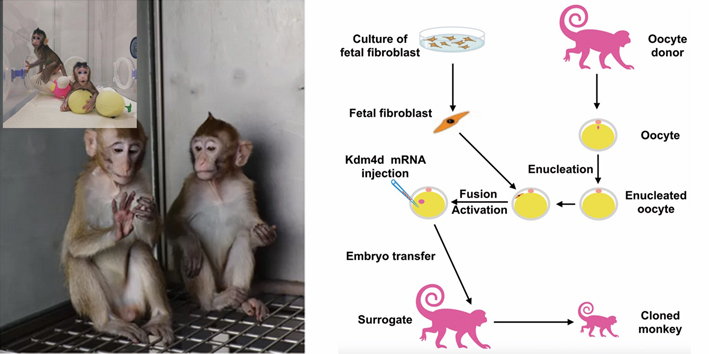
Left: The two cloned monkeys (“Zhongzhong” and “Huahua”) have grown up (inlet). Right: Schemed workflow for creating cloned monkeys by somatic cell nuclear transfer (SCNT) using fetal monkey fibroblasts as the nuclear donor. (Credit: ION)
2nd: All Eggs in One Basket: Creation of Functional Single-chromosome Yeast
Reported by SONG Jianlan

Generally, nucleus-carrying cells have their genome divided into multiple chromosomes. To understand the consequence of manipulating the number of chromosomes in a eukaryotic cell, the joint team from three CAS institutes in Shanghai adventure to fuse the 16 chromosomes in a yeast cell together to produce a huge sing chromosome. Surprisingly, this big change seems to make little damage to the fitness of the cell, though it does affect its growth across different environments, competitiveness, gamete production and viability. (Credit: SIPPE & SIBCB)
Generally, a nucleus-bearing cell has multiple chromosomes, to hold those double-helix chains called DNAs in different “baskets.” All in all, the coding on the “eggs” – those chains – programs how the cell produces the biochemical molecules vital for its whole lifetime, and hence might deserve careful protection. The number of chromosomes varies across species: Human cells each have 46 chromosomes, mice cells 40, fly cells 8, and rice cells 24. How important is the number of “portions” into which a genome is divided? What will happen if we, human beings, change the number of chromosomes? Or, can we put all the genome of an organism into only one single chromosome, without affecting its activity? These remained a long-pending mystery, until scientists from two CAS institutes in Shanghai made the first successful attempt ever to manipulate the number of chromosomes in a eukaryotic cell. Read more…
4th: Starving Tumor Cells to Death by DNA Nanorobots
Reported by YAN Fusheng
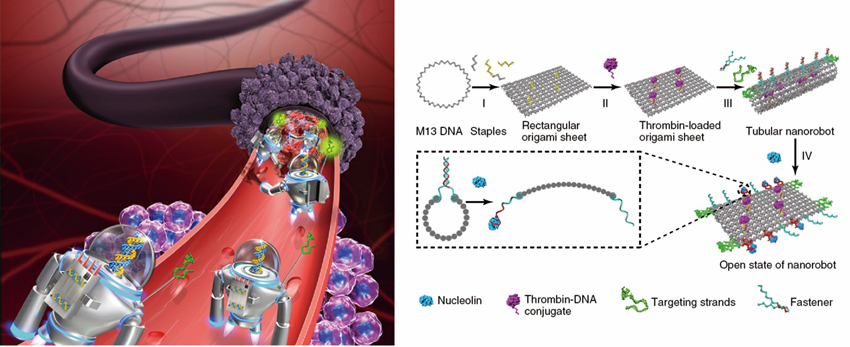
Left: Illustration of the circulating DNA nanorobots working on site by forming blood clots to cut the supplies for tumor cells. Right: Design of the DNA Nanorobot with thrombin in pink, nucleolin in blue and navigating DNA aptamers in green. One of the fasteners that unfold the nanorobot upon docking onto nucleolins is zoomed in. (Credit: NCNST)
Scientists have been long seeking to use smart nanorobots to spontaneously spot and cure human diseases. A breakthrough made early 2018 by a joint team brought us one step closer to this goal. The team designed a kind of DNA-based nanorobots as cancer therapeutic agents. Once introduced into the circulation, these nanorobots can trigger clotting inside blood vessels at the tumor site, cut the blood supply to tumor cells and starve tumor cells to death. Read more…
6th: Hunting for Dark Matter: The First Direct Detection of a Break in the Teraelectronvolt Cosmic-ray Spectrum of Electrons and Positrons
Reported by SONG Jianlan

8thWitness Intracellular Events with New Imaging Tool
Reported by YAN Fusheng
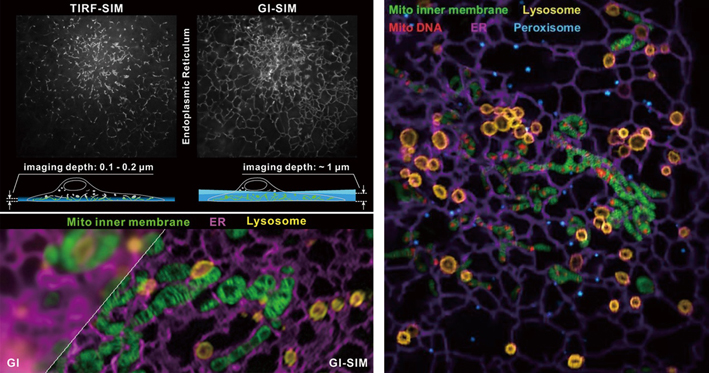
Left: GI-SIM, a new approach of microscopy, enables an in-depth and clearervisionof intracellular organelles.
Right: Multiple intracellular components and their dynamic interactions can be clearly visualized in almost real-time manner with the aid of multi-color GI-SIM. (Credit: IBP)
Seeing is the most direct way we recognize and understand our macroscopic world. This also applies when it comes to gaining insights into the microscopic world in a cell. In 2018, CAS researchers developed a novel microscopic tool, which makes it possible for us to see many interesting interactions involving intracellular organelles and cytoskeletons for the first time. Read more…
9th: Have It All: Enhancing Nitrogen Response in Rice While Inhibiting Its Growth
Reported by SONG Jianlan
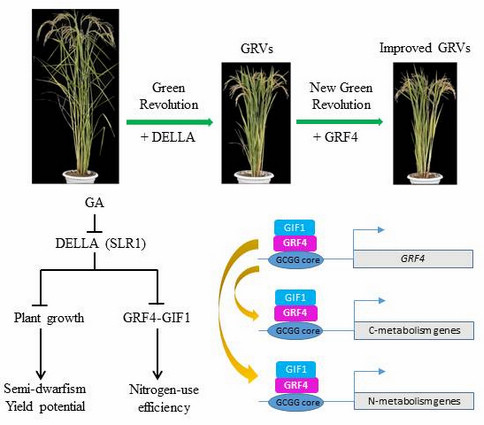
The team unravels how the two competing sides, namely the metabolism promoter GRF4 and the growth inhibitor DELLA, interact with each other and advances to provide a solution to push the balance toward the direction of promoting nitrogen assimilation while maintaining the benefits of dwarfism. (Credit: IGDB)
A team at the CAS Institute of Genetics and Developmental Biology (IGDB) led by Prof. FU Xiangdong offered tips on increasing the efficiency of nitrogen use in rice without sacrificing the benefits of dwarfism. This might help reduce use of chemical fertilizers in agriculture and is thought to have blown the horn for a new round of green revolution. Read more…
10th: New Story of “Out of Africa:” Human Occupation on Chinese Loess Plateau Dated to ~2.12 Ma
Reported by SONG Jianlan
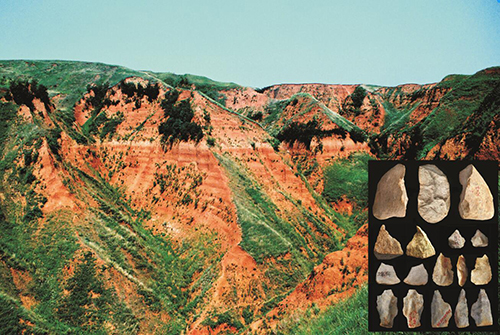
The landscape and loess–paleosol section of the Shangchen Paleolithic locality recently found by the joint team. The discovery here indicates that human beings might have emigrated out of Africa earlier than formerly believed. (Credit: GIG & IVPP)
How our ancestors evolved and emigrated has long been heatedly disputed and pursued, and scientists over the world have been working hard to reconstruct the emigrating history of early humans by identifying and dating ancient sites of human habitation.
The age of the lowest layer of an artefact-carrying sequence, recently found in Lantian county on the southern Loess Plateau of China, turned out to be even earlier than that of the Dmanisi site in Georgia, which was formerly thought to be the oldest outside Africa. Hence the updated age of Lantian might imply a new story of "Out of Africa." Read more…

